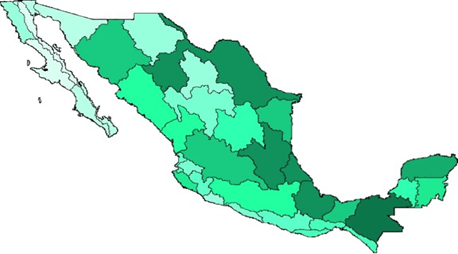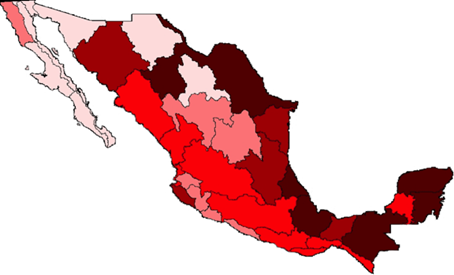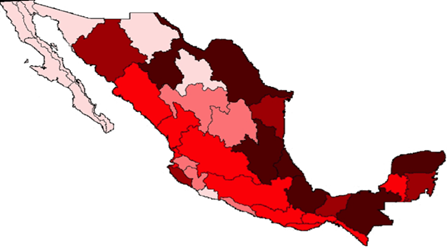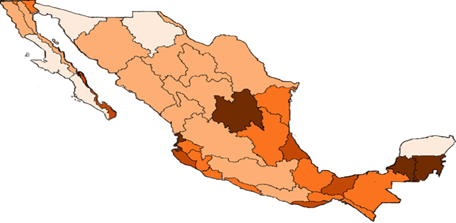


Freshwater’s Fish Species Richness Patterns for Mexico
García-Bedoya D.1, Morales-Romero D.1, Cota-Arriola O.1, Garcia-Baldenegro V.2, Garrobo-Rocha H.M.3, Esquer-Miranda E.2*
1 Environmental Engineering Program, Sonora State University, Hermosillo, Mexico.
2 Horticulture Program, Sonora State University, Hermosillo, Mexico.
3 Ecology Program, Sonora State University, Hermosillo, Mexico.
Abstract
Fishes are the most diverse vertebrates, grouping about 28000 species. Mexico has 25% of this biodiversity and is recognized as the fourth place in the world with 500 species of continental fish, comprised of Nearctic and neotropical species. In this study, six fish collection databases were consulted, and by the use of metadata sites, we ordered and mapped all the continental metadata registers and by a manual search of water bodies, local names, and other site references were consulted for all registers and by the use of the latest taxonomical keys searching for synonyms to eliminate repeated records. We obtained a total of 23,113 registers ordered and classified by site and basin. Our results indicated that from the continental species pool, 65.6% are endemic, and about 27% have some sort of official conservation status. These results showed that there are more than a quarter of the continental fish species and include rare, and recovering populations’. On the other hand, the IUCN red list (2015) of threatened species shows 73 records representing 14% of the total, which is not so far from the 11.8% that is officially recognized by the federal government and its institutions. We can conclude that from this analysis, the real diversity center for the neotropical species is in the Caribbean as the entrance from the Amazonia while the Nearctic diversity center for Mexico is the Rio Conchos basin in Chihuahua.
Keywords: Freshwater fishes, Richness patterns, Neotropical, Nearctic, Mexico
Fish is the most diverse group of the Vertebrata phylum, grouping about 28000 species reported from an estimated total of 35000 species (Eschmeyer 2010; Sarvestani et al., 2017; El Deen et al., 2018; Mirnategh et al., 2018). In particular, Mexico has 25% of this biodiversity, and the fourth place in the world with 500 species of continental fish and about 2500 to 3000 marine species and shares Nearctic (those that originate from the North onto the equator) and Neotropical (those that originate from the South onto the equator) species, that is why Mexico is called a mega-diverse country (Miller et al. 2005; Espinosa et al. 2008). It`s recognized that “fish” is not a taxonomical group per se, in this classification are embed different organisms from agnate (which are phylogenetically different from the rest of the “fish”) onto amphioxus (primitive chordate) and its descendants (Gnatostomates) (Nelson 2006). In consequence, this is a numerous group, but the fact that all this Vertebrata group shares some physical (bilateral symmetry, a notochord, pharyngeal gill slits, fins) and physiological (oxygen uptake trough gills, excretion, poikilothermia) characteristics must be enough to associate them to explain common biogeographical processes such as migrations (Spanier and Galil 1991). Particularly in Mexico, fish biodiversity has been studied since the ’70s (Alvarez del Villar 1970; Leis and Miller 1976) but it took relevance in the ’80s by studies all over the country by Mexicans and American researchers, with collections like those at the UNAM Biology Institute (Central Mexico), UANL at Monterrey (Northwest Mexico), ECOSUR (Southern Mexico) and UABC (Northeast Mexico) and USA collections like Tulane and Michigan which have special Mexico’s collections (from all over the country). With this information, species presence and diversity indexes have been reported for many ecosystems and added new records constantly, but there are few global studies such the Miller book (2005) and those mentioned at Espinosa-Pérez (2014), but there is no analysis about if there are some patterns that explain why converges in Mexico those groups and where maybe the richness hotspot. This lack of global knowledge and the introduction of species for commercial purposes (such as the common carp from China and tilapias from Africa) are jeopardizing the fish biodiversity (Zambrano et al. 2006). In this paper, the central analysis is based on continental fish species trapped by the basins’ geography, and as their actual distribution obeys to geological processes (primary and secondary fish), therefore strictly marine species were not included (Alvarez del Villar 1970; Schmitter-Soto 1998).
Six fish collection databases were consulted; U.N.A.M. Biology Institute (University at Central Mexico), U.A.N.L. at Monterrey (University at Northwest Mexico), ECOSUR (Research Center at Southern Mexico) and U.A.B.C. (University at Northeast Mexico) (All of these accessed personally) and USA collections like Tulane University Museum of Natural History and The University of Michigan Museum of Zoology (Accessed through the Fishnet2 Portal, www.fishnet2.org, 2010-01-14), which have special Mexico’s collections (from all over the country). Using “INEGI” (Instituto Nacional de Estadística y Geografía, federal institution) sites metadata, all the continental records were mapped using the latitude and longitude data shown on the electronic labels and by manually searching for the waterbodies local names and other sites’ references. Also for all the registers, the latest taxonomical keys update searching for taxonomical synonyms were consulted to eliminate repeated records (Nelson 2006; Miller et al. 2005; Froese and Pauly 2016). Then, we generated the corresponding maps through the programs ArcView 3.2 and Photoshop 12.0. Additionally, the IUCN red list of threatened species (IUCN 2015) was consulted with the official local information (NOM-059-ECOL-2010).
A total of 23113 records were ordered and classified by site and basin. From the continental species pool, 65.6% are endemic, and about 27% (136) are considered under some sort of official conservation classification status (Table 1), including more than a quarter of the continental fish and considered rare and recovering population’s species. On the other hand, the IUCN red list of threatened species shows 73 records, which is 14% of the total and is not so far from the 11.8% that is officially recognized by the federal government and its institutions. It is remarkable that the INP in 2017 (Instituto Nacional de la Pesca, federal institution) on its latest estimates, mentions that 75 species are cataloged as exotic species.
Table 1. Fish under some conservation status as at NOM-059-ECOL-2010, classified as rare and exotic by the “Carta Nacional Pesquera” published by the INP in 2017. *The exotic percentage is taken from the total continental species.
|
Number of Species |
Status at NOM-059-ECOL-2010 and INP, 2012. |
Percentage of the continental species total |
|
Endemic |
328 |
65.6% |
|
Threatened |
59 |
11.8% |
|
Endangered |
57 |
11.4% |
|
Rare |
20 |
4% |
|
Exotic |
75 |
15%* |
Species richness maps consider the 43 main basins referenced for the country by the CNA (Comisión Nacional del Agua, federal institution) (Maderey and Torres 1990) These maps were generated from databases created from the collections raw data and were processed in ArcView 3.2 using the metadata for the basins available at the INEGI web page (https://www.inegi.org.mx/). All maps are consistent with the richest region that is for Mexico’s southeast basins, especially the Caribbean region. The specific richness map shows the gulf coast as the richest region (fig. 1), the families’ richness map is also contrasting in this and remark the Yucatan peninsula as a rich spot (fig. 2). Genus richness map shows the same pattern as for families’ one (fig. 3).
A second Pattern is associated with both coastal lines (Pacific and Atlantic), showing more richness than the Central zone like a “V”, increasing the number of species to Southern Mexico and being the south border the richest region. Between the Atlantic and the Pacific oceans, the Atlantic coast is the richest and in the Pacific, the Sonora and Baja California regions have the lowest continental fish biodiversity, which may be related to the superficial water bodies as riverine sites richness map shows in figure 4.
Overall, we elaborate on an image representing the zones with higher species endemism which can be observed in Central Mexico (Mexico valley basin), the north area (Coahuila, Cuatro Cienegas area), Michoacan, Guerrero, and Baja California Peninsula (fig. 5).

Figure 1. The pattern of specific richness for the 43 main Mexican river basins (Maderey and Torres 1990). This map contains the six database arrangement and analysis. Darker color means a higher species number.

Figure 2. Families’ richness pattern for the 43 main Mexican river basins (Maderey and Torres 1990). Darker color means a higher species number.

Figure 3. The pattern of genus richness for the 43 main Mexican river basins (Maderey and Torres 1990). Darker color means a higher species number.

Figure 4. The pattern of specific richness for the 43 main Mexican river basins considers in the reports by riverine sites. Darker color means a higher species number. Darker color means a higher species number.
Figure 5. High species richness regions (red), endemism (yellow), and extinction (black).
These results supported by the analyses of data itself, but reinforced on studies of other groups related with fish such as their parasites (Pérez-Ponce de León and Choudhury 2005); and on other vertebrate taxa indicates the same patterns like reptiles, amphibians, birds and mammals performed by simulation software based on abiotic conditions (Ochoa-Ochoa and Flores-Villela 2006; Kolef et al. 2008). Even the fish pattern found on the Poeciliopsis genus (Huidobro et al. 2006), but for others taxa as well, mentioned in the same paper. This could support the idea that animals, in general, coevolved along with the environment and used the same migrations routes and bridges for their distribution (Huidobro op cit.; Loreau, 2010).
It´s no surprise that the Yucatan peninsula was one of the richer areas; it is considered one of the largest Mexico rivers flow (the Usumacinta and Rio Grande rivers) and connects with the pacific coast (Alcocer and Bernal-Brooks 2010). Also, some authors coincided that in this region may be a biological corridor for the Neotropical species towards the north, due on it is the biggest river in the border with Belize, making it a megadiverse zone (Schmitter-Soto 1998; Gamboa-Perez 1992). This will be supported by the case of the Poeciliidae family which has its origins in South America a long time ago and migrate to the north and in the Belize and Yucatan area occurred great radiation (Dominguez et al. 2006). At the “Rio Conchos” basin there is high radiation of Nearctic species due to the river extension and the intricate conditions of this basin of the Chihuahua Mountains providing a large heterogeneity of habitats (De la Maza 2009). This river system could be the species source for places like “Cuatro Cienegas” in Coahuila which is another hotspot of endemic species in the same region of the north of Mexico (Minckley 1984). This pattern is also observed in a world view, where Neotropical species are in a larger number than Nearctic, Neotropical fish are about 4,035 species in 705 genera while Nearctic fish constitute 1,411 species in 298 genera (Lévêque et al. 2007) and what we see contrasting Yucatan with the Rio Conchos, a larger number with less endemism in the first one and a smaller number but great level of endemism at the second one also due to the functional diversity (Toussaint et al. 2016). These results are similar to another study that mark “Los Llanos” in Venezuela as a high richness spot at a continental scale and is not so far from the Yucatan's peninsula with the difference that in Venezuela the dominant species belonging to the Characidae family (Winemiller 1991; Montaña and Winemiller, 2013).
All patterns may be explained by spatial heterogeneity of the landscape resulting from the high tectonic activity in México. It seems that large volcanic ridges are like barriers for fish distribution, this may explain the high richness in the coastal lines, also the large latitudinal extension helps to the heterogeneity due to the different climates that could be found; the isolation of the endorheic basins helps to develop endemism like on the Mexico valley, the salty crater lakes of Puebla (i.e. Alchichica and its Chirostomas sspp.); the adaptation of the marine fish into the coastal lagoons; and the amount of running water was most species could be founded (Miller and Smith 1986; Miller 1986; Espinosa-Pérez 2014). Also, we can observe that endemism for the inner valleys (between occidental and oriental sierra systems) concur with a high number of Nearctic species (mostly cyprinids), and the coastal line endemism acquiesces with a high number of Neotropical species (mostly cyprinodontoids), these findings could suggest that volcanic ridges directed the colonization routes and its formation aisled those which came from the northern and higher regions (Matthews 2012).
We want to thanks all people involved in this project in all its stages, the people who give us access to the fish collections, the people we consult for synonymies, and the people who gave us comments about the manuscript and all those who participated in any way. Thanks to the fish collections (U.N.A.M; U.A.N.L; ECOSUR; U.A.B.C; Michigan University and Tulane University) for sharing all the information.
REFERENCES
 This work is licensed under a Creative Commons Attribution 4.0 International License.
This work is licensed under a Creative Commons Attribution 4.0 International License.